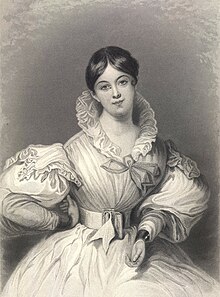Letitia Elizabeth Landon
| Letitia Elizabeth Landon | |
|---|---|

Letitia Elizabeth Landon (1802–1838); variation of the original painting by Daniel Maclise
|
|
| Born |
14 August 1802 Chelsea, London |
| Died | 15 October 1838 (aged 36) Cape Coast Castle |
| Nationality | English |
| Other names | Letitia Elizabeth Maclean |
| Occupation | writer |
| Style | Post-Romantic |
Letitia Elizabeth Landon (14 August 1802 – 15 October 1838), English poet and novelist, better known by her initials L.E.L.
Letitia Elizabeth Landon was born on 14 August 1802 in Chelsea, London to John Landon and Catherine Jane, née Bishop. A precocious child, Landon learned to read as a toddler; an invalid neighbour would scatter letter tiles on the floor and reward young Letitia for reading, and, according to her father, "she used to bring home many rewards." At the age of five, Landon began attending Mrs Rowden's school at 22 Hans Place, which counted among its alumnae Mary Russell Mitford and Lady Caroline Lamb. The family moved to the country in 1809, so that John Landon could carry out a model farm project, and Landon was educated at home by her cousin Elizabeth from that point on. Elizabeth, though older, soon found her knowledge and abilities outstripped by those of her pupil: "When I asked Letitia any question relating either to history, geography, grammar - Plutarch's Lives, or to any book we had been reading, I was pretty certain her answers would be perfectly correct; still, not exactly recollecting, and unwilling she should find out just then that I was less learned than herself, I used thus to question her: 'Are you quite certain?' ... I never knew her to be wrong." When young, Letitia was very close to her younger brother, Whittington Henry, born 1804. Paying for Whittington through university (Worcester College, Oxford) was one of the needs that drove Letitia to publish. She also supported his preferment and later dedicated her poem ‘Captain Cook’ to their childhood days together. Whittington went on to become a minister and published a book of Sermons in 1835. Sadly, he did not show any appreciation for all his sister's financial assistance but spread false rumours about her marriage and death. Letitia also had a little sister, Elizabeth Jane (1806), who was a frail child and died in 1819, aged just 13. Little is known of Elizabeth but her death may well have left a profound impression on Letitia and it could be Elizabeth who is referred to in the poem ‘The Forgotten One’.
The following statements from those who knew her give some idea of the woman known as L. E. L.
Emma Roberts, from her introduction to "The Zenana and other works":
L.E.L. could not be, strictly speaking, called handsome ; her eyes being the only good feature in a countenance, which was, however, so animated, and lighted up with such intellectual expression, as to be exceedingly attractive. Gay and piquant, her clear complexion, dark hair, and eyes, rendered her, when in health and spirits, a sparkling brunette. The prettiness of L.E.L., though generally acknowledged, was not talked about ; and many persons, on their first introduction, were as pleasingly surprised as the Ettrick Shepherd, who, gazing upon her with great admiration, exclaimed " I did na think ye had been sae bonny." Her figure was slight, and beautifully proportioned, with little hands and feet ; and these personal advantages, added to her kind and endearing manners, rendered her exceedingly fascinating.
...
Wikipedia
